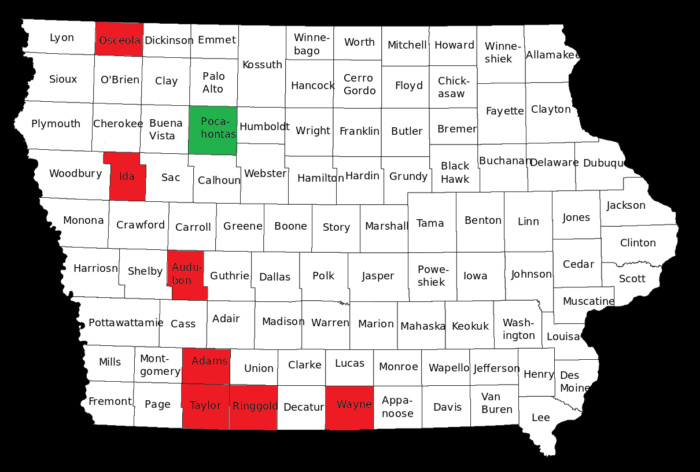The 99-part series continues. You can find previous installments here. -promoted by desmoinesdem
This week I will review our eighth-smallest county in terms of population, Pocahontas County. The 2010 census found 7,310 people living in the entire 579 square miles of the county, the 32nd largest in Iowa. To put this in perspective, Pocahontas County is roughly equal in population to the city of Knoxville (Marion County). Pocahontas County is northwest of Des Moines. According to Google Maps, the county seat of Pocahontas County, Pocahontas, is 136 road miles from the Iowa State Capitol building in Des Moines.
Pocahontas County was founded in 1851 when it was formed from Greene and Humbolt Counties. The county was named after the Native American princess Pocahontas from Jamestown, Virginia.
In a bit of a different trend from our first counties, the highest population in Pocahontas County (16,266) was in the 1940 census. Pocahontas County has lost population in every census since that time, and in 2010 had roughly half the population that it had in 1960.
The racial makeup of the county in 2010 was 98.49 percent White, 0.24 percent Black or African American, 0.17 percent Native American, 0.17 percent Asian, 0.01 percent Pacific Islander, 0.30 percent from other races, and 0.61 percent from two or more races. 0.89 percent of the population was Hispanic or Latino of any race.
Some 6.6 percent of the population lives in households with income at or below the poverty level. Average personal income was estimated at $40,374, which was the 30th highest of Iowa’s 99 counties. Pocahontas County had the 18th lowest unemployment rate in 2010 (tied with several others), 5.1 percent. (As of December 2016 the unemployment rate was 2.8 percent.)
In terms of educational attainment, Pocahontas County has the 37th lowest rate of residents having received a bachelor’s degree or higher, 16.4 percent. The overall rate in Iowa is 24.8 percent, as a comparison.
Pocahontas County is currently a part of the fourth Congressional district and has been represented by Steve King (R) since 2003. Currently Pocahontas County is a part of Iowa Senate district 5, represented by Tim Kraayenbrink (R) and part of Iowa House district 10, represented by Mike Sexton (R).
2016 Elections Results
Donald Trump 2,702 (69 percent) Hillary Clinton 963 (24.6 percent) Others 253 (6.4 percent)
US Senate Chuck Grassley 2,891 (73.8 percent) Patty Judge 784 (20 percent) Others 243 (6.2 percent)
US House Steve King 2,642(70.6 percent) Kim Weaver 1,096 (29.3 percent) Other 4 (0.1 percent)
Iowa Senate- No Race
Iowa House- Mike Sexton -UNOPPOSED
Since 1960, the Republican Nominee has carried Pocahontas County ten times and the Democratic Nominee five times, with the most recent Democratic victory in 1996. Romney carried Pocahontas County in 2012 by 21.7 percent while Trump won in 2016 with a 44.4 percent advantage!
The Pocahontas County Board of Supervisors has an interesting mix of 2 Democrats, 1 Republican, and 2 Independents. The county recorder is a Democrat; all other offices are held by Republicans.
Looking back at the 2014 elections, Tim Kraayenbrink carried the Iowa Senate race with 66 percent of the vote. Joni Ernst carried Pocahontas County with 64.9 percent of the vote against Bruce Braley, and Governor Terry Branstad received 68.8 percent against Jack Hatch, so Democrats losing in the county by wide margins is a continuing trend.
While Pocahontas County was an another electoral disaster for Democrats in 2016, in the county Democrats were competitive and won in the 80’s and 90’s as well as in the national Lyndon Johnson landslide of 1964.
Many 2016 election post mortems have pointed out the disastrous (for Democrats) collapse of support in rural areas that have little demographic diversity. Pocahontas County is an yet another example where this problem is long standing, and 2016 was marginally worse than recent elections. Democrats cannot expect to find electoral success when losing counties by 44 percent in Presidential elections, 54 percent in Senate elections, and definitely not by failing to have a candidate for Iowa Senate races.
Next week: Fremont County.

